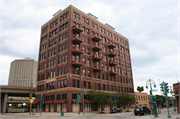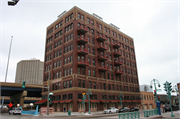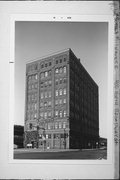Property Record
400 N BROADWAY ST
Architecture and History Inventory
| Historic Name: | E.R. Godfrey & Sons Co. |
|---|---|
| Other Name: | |
| Contributing: | Yes |
| Reference Number: | 98163 |
| Location (Address): | 400 N BROADWAY ST |
|---|---|
| County: | Milwaukee |
| City: | Milwaukee |
| Township/Village: | |
| Unincorporated Community: | |
| Town: | |
| Range: | |
| Direction: | |
| Section: | |
| Quarter Section: | |
| Quarter/Quarter Section: |
| Year Built: | 1911 |
|---|---|
| Additions: | C. 1949 |
| Survey Date: | 20002010 |
| Historic Use: | industrial bldg/manufacturing facility |
| Architectural Style: | Commercial Vernacular |
| Structural System: | |
| Wall Material: | Brick |
| Architect: | Schnetzky and Son |
| Other Buildings On Site: | |
| Demolished?: | No |
| Demolished Date: |
| National/State Register Listing Name: | Historic Third Ward District |
|---|---|
| National Register Listing Date: | 3/8/1984 |
| State Register Listing Date: | 1/1/1989 |
| National Register Multiple Property Name: |
| Additional Information: | Interior altered after 1949. Eight story brown brick with glazed yellow brick and terra cotta trim; commercial style. Green marble entrance of later date. E.R. Godfrey & Sons Co. was a highly respected commission & wholesale grocery firm established in 1887. Their Silver Buckle brand coffee was roasted on the 8th floor. It is claimed that Godfrey was the first to operate a combined wholesale grocery/fresh fruit and produce business in the lower Third Ward wholesale neighborhood; that the firm was responsible for shipping in Milwaukee's first bananas; that it was the first to enter the frozen food business in the Milwaukee area. In 1926, James Godfrey established the Independent Grocers Alliance (IGA), and his firm became one of the state's three IGA suppliers. In 1953, due to competition from the revolutionized supermarket, the firm formed its own chain of Sentry stores, which grew to include 80 stores in Wisconsin. Following Godrey & Sons departure in 1949, the building was occupied by the Bruce Publishing Co., a printer of Bibles and other liturgical material. W.G. Bruce, noted local historian/biographer, remodeld the building extensively, using fine interior woodwork to create a fancy diningroom and chapel. Pending a decision regarding new liturgy during Pope John XXIII's reign, the firm ceased printing and went out of business. The building was occupied by another religious firm, then was empty from 1971-74. The LoDuca firm moved in in 1974; it imports and exports, wholesales and retails musical instruments and cases and offers music instruction. The first floor is leased to a printer. With the exception of the first story windows and entrances, the building's exterior is intact. Resurveyed for Milwaukee Downtown Connector Arch/History Survey, SHPO#10-0983, Prepared by Heritage Research (2010). Resurveyed 2011. Appearance unchanged. |
|---|---|
| Bibliographic References: | Historic Third Ward Historic Walking Tour, Historic Third Ward Association, 2009. |
| Wisconsin Architecture and History Inventory, State Historic Preservation Office, Wisconsin Historical Society, Madison, Wisconsin |





